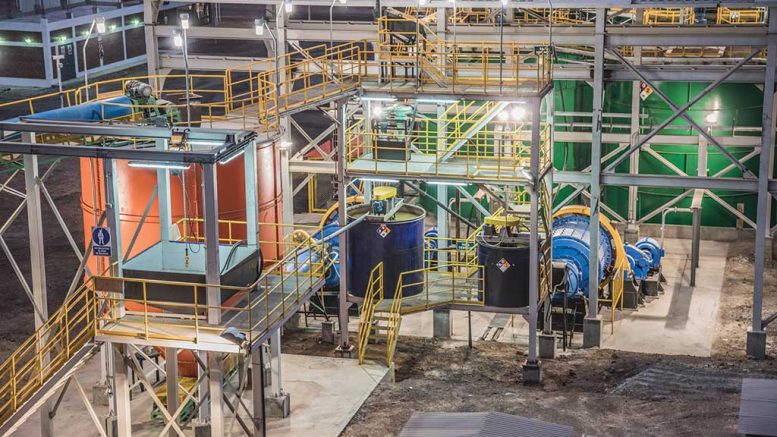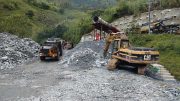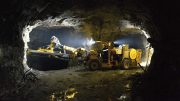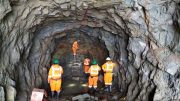Dynacor Gold Mines (TSX: DNG; US-OTC: DNGDF) is not your typical junior.
The company buys ore from registered artisanal miners in Peru and processes it into doré at its Veta Dorada plant, 600 km south of Lima.
The processing plant poured its first gold in October 2016 and produced 79,897 oz. in 2017.
“We are confident that in 2018 we will further increase this, as the company closes in on the 100,000 oz. per year production level,” Jean Martineau, Dynacor’s president and CEO, says in a telephone interview from his office in Montreal. “I don’t think we’ll be able to reach 100,000 oz. this year, but we’ll be pretty close to that, maybe around 90,000 or 92,000 ounces.”

Jorge Luis Cardenas (left), project general manager, and Jean Martineau, Dynacor Gold Mines president and CEO, display a gold bar in the Veta Dorada gold mill in Peru. Credit: Dynacor Gold Mines.
The mill, which can be expanded to 600 tonnes per day as required, reached a throughput of 300 tonnes per day at the end of November, and Dynacor’s next goal is to ramp it up to 360 tonnes per day before year-end.
“We’re not a regular mining company, as you know. We don’t dig our own holes. We buy ore, and we are generating good cash flow,” Martineau says.
The company generates so much cash, in fact, that it paid off its outstanding debt in December — 13 months ahead of time — and still had $5 million left in the till.
Dynacor initially borrowed a $7-million, senior-secured credit facility from a Toronto-based company in January 2016. It didn’t have to pay it back until January 2019, but was eager to do so to avoid hefty lending rates. Last year the company paid $750,000 on interest and financial fees alone.
“We wanted to eliminate that,” Martineau says. “Now we’re debt free, the mill is working very well, and so this year will be a very, very good year.”
Not having any debt, he adds, “opens up doors to other possibilities, so it’s very interesting — it puts us in a very good situation — and we’ve been looking for different opportunities.” Martineau won’t say what these new opportunities might be, or where. “Right now we haven’t decided,” he says, adding only that they could be outside Peru.

Examining a rock sample at Dynacor Gold Mines’ Tumipampa gold-copper project, 500 km southeast of Lima. Credit: Dynacor Gold Mines.
In October 2017, the company signed a strategic alliance with PX Precinox, a privately held Swiss refinery and manufacturer of finished and semi-finished precious metal producers for the hi-tech and luxury industries.
The alliance involves jointly developing a business-to-business responsible gold program, under which all the gold Dynacor produces will be marketed under the label PX Impact Gold and sold to some of the world’s leading luxury jewellery and watchmakers, who are keen to buy socially responsible and traceable gold produced by artisanal miners. Buyers of PX Impact Gold, Dynacor says, will pay a premium for socioeconomic development projects in Peru for artisanal miners and their communities.
In addition to its milling business, Dynacor has an exploration property called Tumipampa, a gold-copper project 500 km southeast of Lima.
The 97.6 sq. km property sits 4,500 metres above sea level on a barren plateau that straddles the Andahuaylas-Yauri porphyry and skarn belt to the east, and a regionally trending corridor of epithermal gold and silver mineralization to the west — both hosting large base and precious-metal deposits.
Over the last year, Dynacor’s shares have traded between $1.50 (December 2017) and $2.58 (March 2017).
At press time the company’s shares were changing hands at $1.93. Dynacor has 39 million common shares outstanding for a $75-million market capitalization.






Be the first to comment on "Dynacor’s artisanal mining strategy pays dividends"